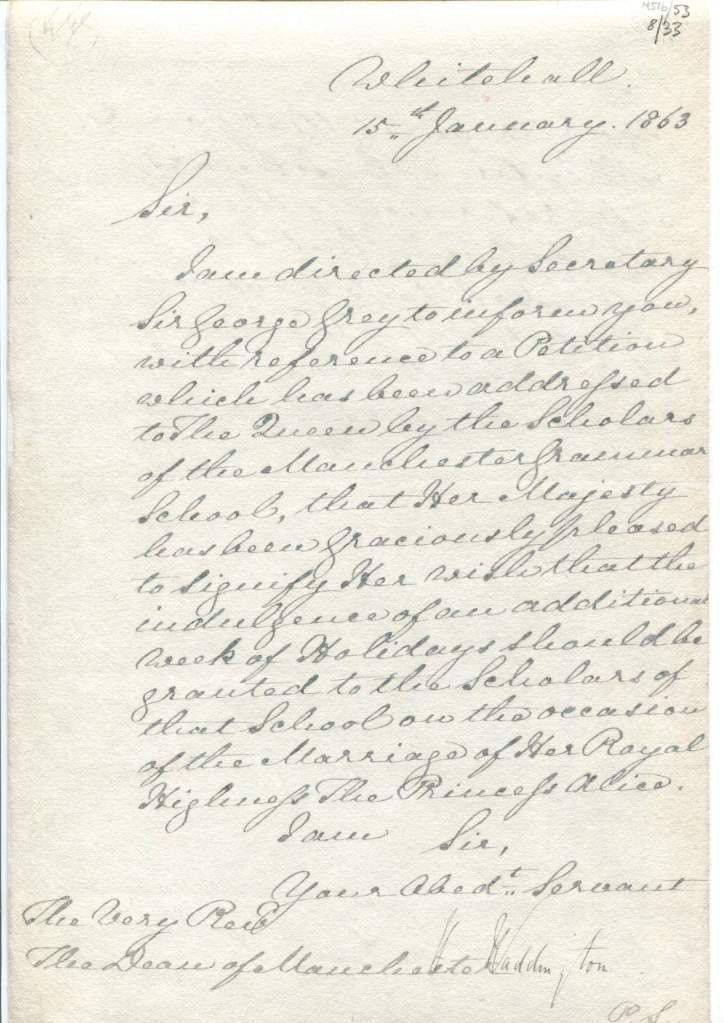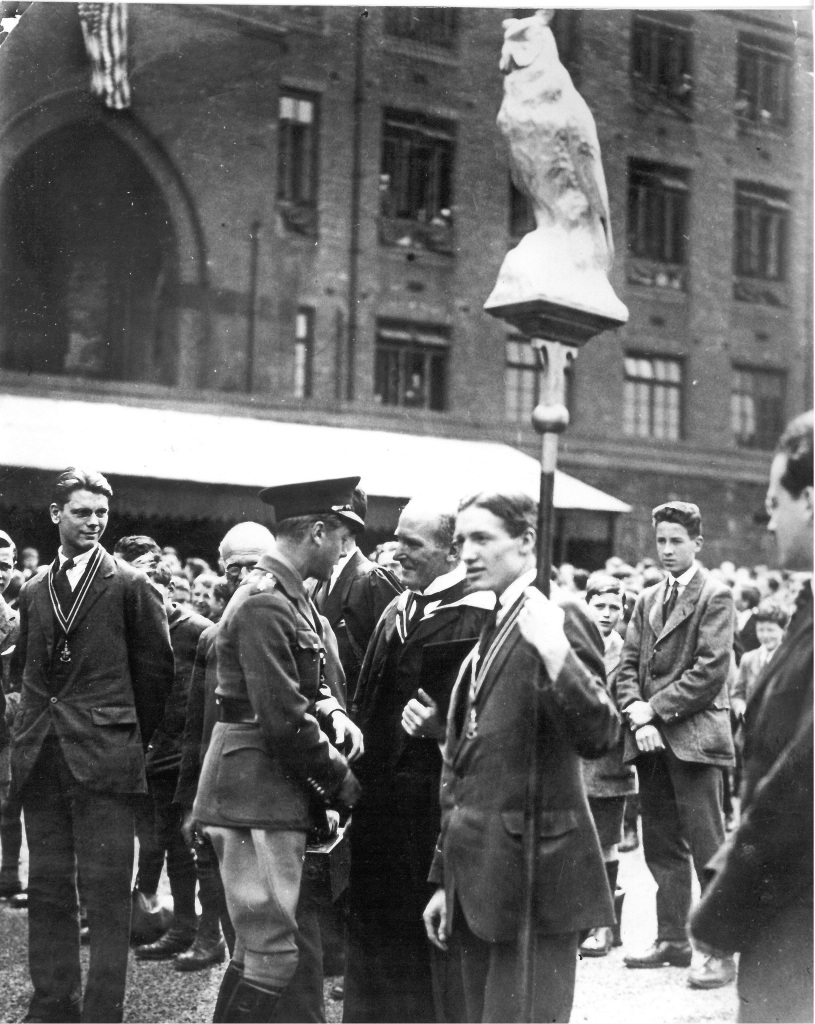School trips now seem a regular and reliable part of MGS life, aside, of course, from the Covid-related interlude of 2020 – 2021.
Surprisingly, the first school trip recorded in Ulula was a foreign trip to France in 1873, in the magazine’s second edition. “Our Trip to France” describes a trip to Paris by twenty boys, who spent over a week in the city in the summer holidays. This first foreign trip however would prove to be a flash in the pan, with a comparable trip abroad not organised again until the Edwardian period.
The first domestic trip recorded was a suitably educational visit – to Castleton in Derbyshire on “a scientific excursion“. Mr. Jones and the Upper Science Forms embarked on the trip in July 1875, visiting the Speedwell mine and sailing into the cavern, as well as looking for geological finds in a nearby quarry. Other trips recounted in the magazine include a six day cycling trip to Warwickshire, with boys covering over 250 miles, and a Debating Society picnic to Bakewell. It seems that during this early period, individual pupil societies took topical excursions and trips. For example, the Natural History Society took biannual trips in term-time during the 1880s and 90s. In June 1891, the society took a trip to Alderley Edge to examine mosses, insects and trees. The Photographic Society which was set up in the 1890s also included trips as part of its programme.

Nevertheless, regular travel, even domestic, does not seem to have been a consistent feature of MGS life in the late-nineteenth century. By the turn of the century, Ulula did however feature pieces by Old Mancunians and current boys outside of school on their experiences of overseas travel with accounts of the Black Forest, South Africa, Holland and Belgium.
It was during J.L. Paton’s time as High Master (1903- 24) that MGS began to offer a wider programme of school trips, as well as beginning the School’s long tradition of camps and treks, which have been written about extensively elsewhere. J.L. Paton’s father was friends with Thomas Arthur Leonard, having taught him at the Congregational Institute in Nottingham. Leonard advocated for holidays and outdoor recreation for the urban working classes, and with Paton senior he founded the Cooperative Holidays Association. He later had a hand in the creation of the Youth Hostels Association and the Ramblers Association. This was clearly a strong influence on the young Paton, and by the time he was High Master at MGS, Arthur Leonard was living in Marple Bridge near Stockport. He helped Paton to organise the first MGS foreign treks.
1902 saw what seems to have been the first foreign excursion since Paris in 1875; a group of boys went on a walking holiday in Switzerland. In May of the following year, boys undertook an impressive cycling trip from Manchester, using a route that would take them through Cheshire, down into the Midlands and on to Oxford, Southampton and the New Forest. The journey home took in Bath, the Wye Valley, Herefordshire and Shropshire, and in total the boys covered over 500 miles.
Less glamorous trips closer to home during this period included a visit to the Manchester Corporation Electric Works, Widnes Alkali works, Pilkington Glass Works, the offices of the Manchester Evening News and Edmund & Potter Co calico-printers, as well as taking a cruise on the Ship Canal.
In 1904 High Master Paton set up a new society devoted to field trips – “The New Field Club” – with the intention to create a programme of excursions during the summer holidays. This increased the numbers of such visits which had previously been organised by the Natural History and Photographic societies. Trips to local places of interest included to Worsley Old Hall, Delamere Forest, Featherbed Moss and Disley.
Most domestic and foreign trips in the 1910s fall into the category of “trek” or “camp” with boys exploring the Black Forest and Northern France, and the focus was on travelling long distances on foot. Aside from the visits organised by the “Field Club”, occasional “Saturday rambles” and sporadic local visits, a more typical school trip was not organised until after the Great War. Even a trip to London in October 1914 became a “camp”, with the boys pitching tents at a Baptist Training College near London Zoo – “At supper the braying of the animals at the Zoo, when the fags brought the cocoa round, came as a surprise to those of us who were unaccustomed to London ways, but of course we got used to it after a time.“
The outbreak of war in 1914 naturally put paid to any expansion of overseas visits. The final trip before the war was a particularly dramatic Scouting expedition undertaken in the summer of 1914, with MGS boys and staff travelling across France at the point that war was declared. More has been written about this trip here
Post-war, it took a while for the rhythm of school life to resume. However, by the 1920s, day trips and holidays had become cheaper. 1922 saw the School’s School’s first foray into Africa, with a party of twenty-four boys and staff travelling to Morocco and Algeria. The trip was so successful that it was repeated again annually until 1934.




The next memorable overseas trip, and by this point the first “long haul” excursion, was during Douglas Miller’s time as High Master. J.L. Paton had stepped down in 1924 and had moved to Newfoundland to become the first President of Memorial College. In August 1926 forty pupils embarked on the S.S. “Nova Scotia” to visit Paton and experience life in Canada. The journey itself was an adventure for the boys, with the voyage taking four days. Ulula reported that they initially tried to stage a sports day on deck but “as most of those who entered for events were sick immediately after, it was deemed wise not to repeat the attempt.” The party spent two and a half weeks in Newfoundland, camping near the University on a site sourced for them by Paton, and by all accounts had a wonderful time. A trip to Switzerland followed in 1926.



By 1929, trekking and camping were already becoming distinctive parts of School life – some of these were “official” camps and treks, whilst others were undertaken by the various Scout Troops that had been set up and were affiliated to MGS. This gave boys by this point a wide choice of places to go. A letter was written to the editor of Ulula suggesting that the School’s song, “The Holiday Song” be updated to include these elements:
“Dear Sir,—It has been suggested that one or more verses might with advantage be added to this song, referring more particularly to the greater range of the summer activities of the M.G.S. boys in these days.
Blackpool and the Isle of Man, North Wales and Windermere, and even“ Corrievreckan drear,” are no longer quite typical of the scenes visited, and there is no reference to camps, treks, and trips abroad, which are now a common feature of the holiday life of the School, a feature for which it is justly famous.
The following verse, which is no doubt open to criticism on several grounds, was compiled by a number of boys who visited Switzerland last year, and was sung at the evening concerts there with keen appreciation of the local allusions. It may serve at least as an indication of what might be done, and could easily be improved upon :—
“And when in Bernia’s mountains
We roam ’midst ice and snow,
By Lauterbrunnen’s fountains
To Blumental aglow;
Thy stately moving glaciers,
Thy peaks serene and white,
O Grindelwald we know thy charm,
We hail thee with delight.”
Hurrah, etc.
Yours, etc.,
Helveticus“
[We print this letter with pleasure, but our own opinion is clear that a school song should be left in the state in which it was written, even if it “ dates.” It has not, we think, been proposed to add the name of Baldwin to the Harrow School song in which occur the names of Byron and Peel.—-Ed., Ulula.]
The 1930s saw some more exotic trips with a Mediterranean cruise on the SS Doric offered in 1935, with the boys visiting Naples, Pompeii, Siciliy and Sardinia. A similar trip was repeated in 1936:

Trips to Germany and Switzerland were also offered in this decade and in 1931 the boys visited the League of Nations in Geneva. Regular school day trips continued to flourish, and the archive holds a number of photographs of domestic school trips from this period:







Naturally the war years interrupted this busy programme, but by the 1950s trips were back on the agenda. Gilbert Roscoe (OM 1953 – 61) has sent the archive these photographs of a trip to Sandhole colliery near Swinton in the early 1950s, including an unusually informal shot of High Master Eric James who joined the boys.

Into the 1960s, school trips remained a regular feature of School life, and with the camps and treks also on offer, MGS boys had a wide choice of extra-curricular travel opportunities. In this decade regular ski trips began to be organised. New ground was broken in the late 60s and early 70s with trips to Iran, Russia and Iceland. These trips were rightly called “expeditions”, and in Iran, boys and staff spent the entirety of the summer holidays undertaking geological study. Similarly, the India expeditions of the 1980s and 90s, and the China trips of the 90s and 00s expanded the horizons of MGS boys.




A plethora of trips, both foreign and domestic, continue to be offered to MGS boys. As mentioned earlier, the pandemic years led to a drop in the number of trips offered. However the 2022/23 academic year saw the School offering nearly 300 separate trips to boys. It has been calculated by the trips office that there were over 19,000 “boy days” of trips in that one academic year alone. Recent foreign destinations have included Costa Rica, Mexico, Peru, Russia, China and Cuba.
The traditions of trekking and camping, both in the UK and overseas, are best dealt with separately. More can be found on MGS Life:
MGS Life hosts a number of articles and images of various MGS Trips and Expeditions:
Russia 1967







